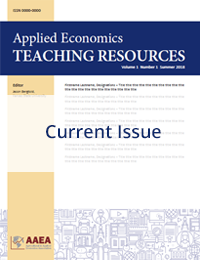Hedging with Futures: An Experiential Learning Game
John Michael Riley
Oklahoma State University
JEL Codes: A20, Q02, Q13
Keywords: Experiential learning, futures, hedging, teaching
First Published Online: March 28, 2020
Volume 2, Issue 2
View Full Article (PDF) | Request Teaching Notes/Supplemental Materials
Abstract
Hedging is often an integral concept in agricultural futures and marketing courses as well as extension marketing workshops. Textbook and chalkboard examples offer students of these courses the ability to understand the concept and learn the mathematics. However, this mode of instruction is less intuitive and does not have a real-world feel. The purpose of this paper is to present an interactive hedging game that was developed to provide students with a more realistic hedging experience that improves the understanding of the mechanics of hedging. Under the premise of an eastern Nebraska corn producer using actual data, a spreadsheet was designed that displays market information to the students who then must make decisions about the number of futures contracts to trade. Pre- and post-game results indicate a positive learning outcome, and students responded favorably when asked if the game enhanced their understanding of hedging.
References
Andreasen, R.J. 2004. “Integrating Experiential Learning into College of Agriculture Capstone Courses: Implications and Applications for Practitioners.” NACTA Journal 48(1):52–57.
Blank, S.C. 1985. “Effectiveness of Role Playing, Case Studies, and Simulation Games in Teaching Agricultural Economics.” Western Journal of Agricultural Economics 10(1):55–62.
Boehlje, M.D., and V.R. Eidman. 1978. “Simulation and Gaming Models: Application in Teaching and Extension Programs.” American Journal of Agricultural Economics 60(5):987–992.
Caudle, L., and T.H. Paulsen. 2017. “Evidence of Critical Thinking in a Capstone Course: A Historical Perspective.” NACTA Journal 61(3):208–218.
Edgar, D.W., M.S. Rettallick, and D. Jones. 2016. “Research Priority 4: Meaningful, Engaged Learning in all Environments.” American Association for Agricultural Education National Research Agenda: 2016–2020. Gainesville, FL: Department of Agricultural Education. http://aaaeonline.org/resources/Documents/AAAE_National_Research_Agenda_2016- 2020.pdf
Knobloch, N.A. 2003. “Is Experiential Learning Authentic?” Journal of Agricultural Education 44(4):22–34.
Livestock Marketing Information Center. Daily, Weekly, and Monthly Corn Futures Prices. Compiled from Chicago Board of Trade. Retrieved from: http://lmic.info/members-only/Spreadsheets/Feedstuffs/FuturesPrices
Livestock Marketing Information Center. Weekly Cash Grain Prices. Compiled from multiple U.S. Department of Agriculture, Agricultural Marketing Service’s cash market reports WH_GR110. Retrieved from: http://lmic.info/members- only/Spreadsheets/Feedstuffs/CashPrices
Purcell, W.D., and S.R. Koontz. 1999. Agricultural Futures and Options: Principles and Strategies, 2nd ed. New York: Macmillan Publishing.
U.S. Department of Agriculture, National Agricultural Statistics Service. 2015. Nebraska Field Office County Estimates. Retrieved from: https://www.nass.usda.gov/Statistics_by_State/Nebraska/Publications/County_Estimates/index.php
Articles in this issue
Teaching Information Literacy: A Case Study of the Ripple Effect in Teamwork
Christiane Schroeter, Lindsey Higgins, Hannah Hank, and Caitlin Stevenson
Facilitating Higher Order Learning: Examining Student Outcomes after a Course Redesign
Anna Josephson, Larry DeBoer, Dave Nelson, and Angelika Zissimopoulos
Hedging with Futures: An Experiential Learning Game
John Michael Riley
Using Data Analytics and Decision-Making Tools for Agribusiness Education
Matthew S. Elliott and Lisa M. Elliott
Personalizing Online Classes: The Use of Evaluation and Participation Tools
Luis Pena-Lavano
The Do Now: A Simple, but Effective Active Learning Strategy
LaPorchia A. Collins


